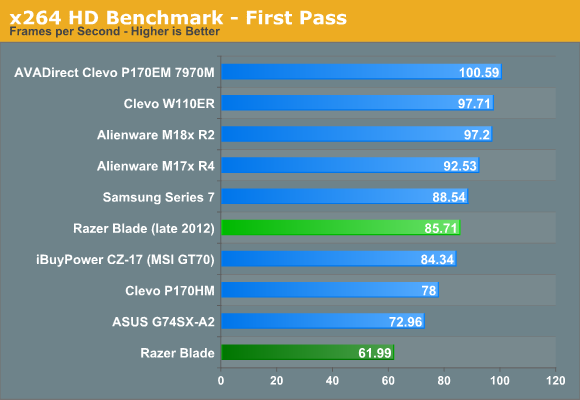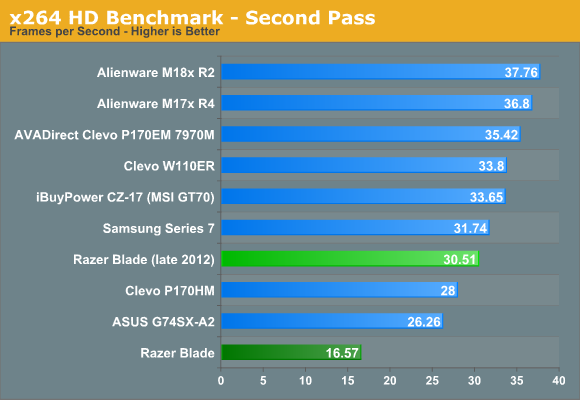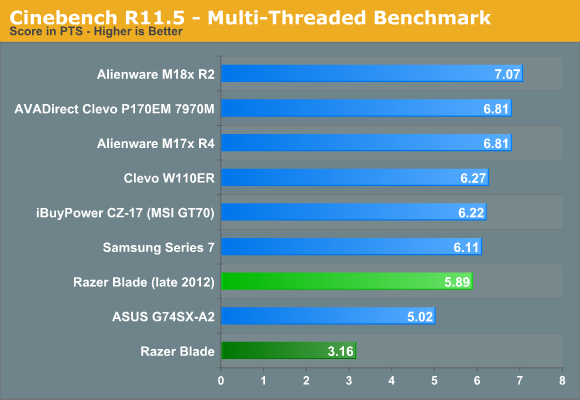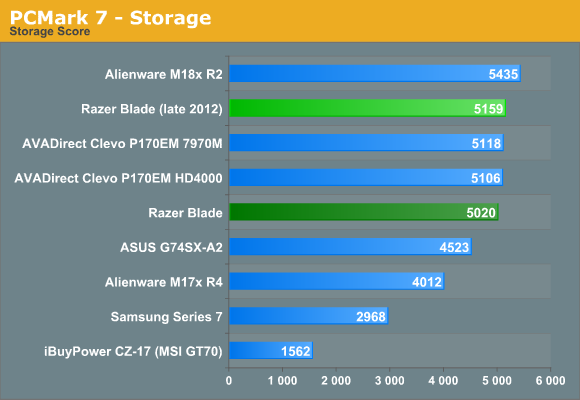The New Razer Blade: Thoroughly Reviewed
by Vivek Gowri on October 3, 2012 5:40 PM ESTRazer Blade (late 2012) - Performance
To gauge how the new Blade stacks up versus its predecessor and other gaming-class notebooks, we picked a decent selection of systems with the entire range of modern GPUs, from the GT 650M GDDR5 in Samsung's Series 7 to the pair of Alienware systems with GTX 680M and 680M SLI graphics configurations. There's a decent range of storage technologies on display here as well, with a number of different SSDs and hybrid storage solutions, along with one conventional 7200RPM hard drive.
| Notebook Configuration Overview | ||||
| CPU | Graphics | Storage | Battery | |
| Alienware M17x R4 | i7-3720QM | GTX 680M | Hybrid (Intel SRT) | 90Wh |
| Alienware M18x R2 | i7-3820QM | GTX 680M SLI | 2x SSD 830 (RAID) | 97Wh |
| ASUS G74SX-A2 | i7-2630QM | GTX 560M | Intel 320 SSD | 90Wh |
| AVADirect Clevo P170EM | i7-3720QM | HD 7970M | Crucial M4 SSD | 77Wh |
| Clevo W110ER | i7-3720QM | GT 650M | Hybrid (Momentus XT) | 62Wh |
| iBUYPOWER MSI GT70 | i7-3610QM | GTX 675M | 7200RPM HDD | 60Wh |
| Razer Blade | i7-2640M | GT 555M | Lite-On M2S SSD | 60Wh |
| Samsung Series 7 | i7-3615QM | GT 650M | Hybrid (ExpressCache) | 77Wh |
| Razer Blade (late 2012) | i7-3632QM | GTX 660M | Hybrid (DataPlex) | 60Wh |
The Blade is the first 35W quad that I’ve dealt with, and it’s the only 35W quad to go through our labs since Dell’s XPS 15 a few months ago. The Blade uses a new OEM-specific i7-3632QM that is essentially the same as the i7-3612QM in the Dell, except with 100MHz faster clocks. Performance-wise, it falls in roughly where you’d expect a 2.2GHz Ivy Bridge quad, a bit faster than the SNB quads and the 2.1GHz i7-3612QM but a bit slower than the various IVB quads that are clocked faster, starting with the 2.3GHz i7-3610 and 3615QM. I'm going to skip straight to the CPU testing this time, as I find PCMark 7 to be far too heavily skewed by other factors (SSD, Quick Sync, etc.)




There’s not too much else to say about Ivy Bridge here; it’s just a really solid CPU that’s done well for Intel. The only complaint that really can be leveled against it is that even though the tick+ update focused heavily on a new on-die graphics architecture, Intel is still playing catch up to AMD’s far more advanced integrated graphics solutions. Intel’s HD 4000 is solid enough for anything not involving gaming though, and in these applications at least, it does its job well.
Traditionally, I try to avoid all Futuremark tests, but I decided to break my rule here with the PCMark 7 storage benchmark. I wanted to see how effective NVELO’s DataPlex caching solution was with respect to Intel’s Smart Response Technology as well as the SSD in the previous Blade. The PCMark Storage score is pretty impressive, beating the SRT-enabled Dell XPS 15 (which had a 32GB cache drive) and interestingly, the old Blade as well. Admittedly, the original Blade’s SSD wasn’t the fastest in the world, even though it used the same Marvell controller as the caching SSD in the new Blade (and the Intel SSD 510, amongst other notable SSDs). We saw better Storage benchmark scores out of faster SSDs in the ASUS N56VM, which was tested using a SandForce-based drive, and Alienware M18x R2 (two Samsung SSD 830s in RAID).

It was a pretty impressive showing, and I actually wasn’t put off by the hard drive too much in day to day usage. The one place where I missed the SSD? Shut down/restart and sleep/wake cycles. I timed a cold boot at 20.8 seconds, a solid 5 seconds off the pace of the old SSDified Blade, and it was definitely something you were reminded of every time the system was rebooted or woken from sleep. As much as the new caching solutions help, nothing can touch the outright responsiveness of a real SSD.










59 Comments
View All Comments
Rezurecta - Thursday, October 4, 2012 - link
One question. Do you think MBP's are overpriced?ahamling27 - Thursday, October 4, 2012 - link
They sure are, but if you want OSX on a laptop, you don't have much choice. You can get a better W7 gaming laptop for much cheaper.solinear - Thursday, October 4, 2012 - link
This kind of comment reminds me of the late 90s linux users, who bragged about how they spent $150 less on their systems and could do "everything I could" (except use software)... then a few years later went out and spent $2000 on a Mac with OSX and talked about how awesome it was and suddenly the price argument they previously had was not only not there, but they refused to discuss price when I brought that up.Price is important, but it's just part of a package. I think that the Razer package is probably worth ~$2000, though I might go with an HP instead (Alienware feels legacy to me) when I buy a new laptop. However, this is definitely on my short list for laptops.
The feature set is really nice and the fact that I wouldn't have to go "Which one of these ports is USB3 again?" or move a device out of a port to use the one that I need for something is more than a small amount of convenience.
Basically this laptop has everything that I'd want for the next 2-3 years in a laptop except for the SSD and RAM. Like others said, I'd rather have 16+GB RAM and an OS/apps drive that is a 256GB SSD and a platter-based disk for data or apps that I am not as concerned about performance on. That's what we did with my wife's HP laptop and we couldn't be happier with it.
Clockwurk - Thursday, October 4, 2012 - link
The problem with them making a "premium" product is that they aren't using "premium" parts. They are using middle of the road hardware and calling it "premium". That's what I have a problem with.Seems to work well enough for Apple, no?
ahamling27 - Thursday, October 4, 2012 - link
Yes, but with Apple your buying OSX not a W7 gaming machine. You're comparing apples to oranges, no pun intended, and it does work well for them.Except the rMBP has a better screen, faster processor, industry leading trackpad, but the gpu is a 650(for what it's worth, it's overclocked an extra 165 mhz). Plus, it's about $300 cheaper, and you have the option of a larger SSD.
Zap - Friday, October 5, 2012 - link
Buying ANY notebook computer is picking form over function. If you want highest performance for a lower price while still keeping some sense of portability, then build a mini ITX gaming rig. Remember that Silverstone SG05 that was reviewed in the past couple months? You can build one with an overclocked Core i7 and GTX 680, with a lot more storage space too.What's the point? Any computer choice is always a tradeoff. Pick your poison.
santeana - Thursday, October 4, 2012 - link
Why comment? It is a valid point. I happen to agree with him. For just over half that price you can get the same chip with a premium display and your choice of AMD 7970m or NV GTX685m and it's only slightly thicker than this one. It's certainly a nice machine and I like the sleekness of it, but honestly it looks similar to the Sager/Clevo I just described and it's hundreds of dollars more.N4g4rok - Wednesday, October 3, 2012 - link
Personally, i wish more laptops did that with the trackpad. The placement makes more sense when you're use to mouse and keyboard. That, and i won't hit it while i'm typing.inighthawki - Wednesday, October 3, 2012 - link
I'd prefer a numpad there myself.HisDivineOrder - Wednesday, October 3, 2012 - link
Ditto.